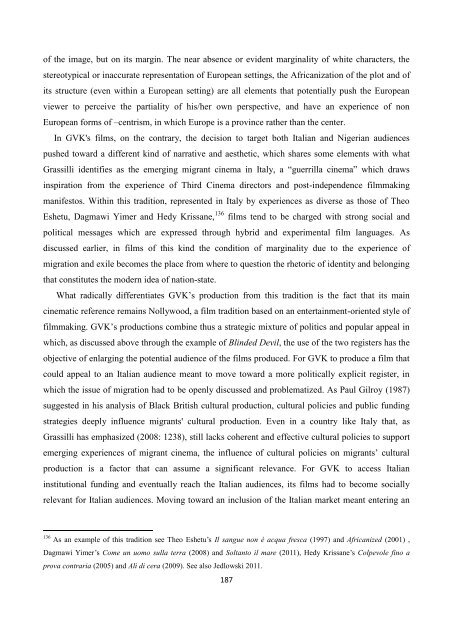You also want an ePaper? Increase the reach of your titles
YUMPU automatically turns print PDFs into web optimized ePapers that Google loves.
of the image, but on its margin. The near absence or evident marginality of white characters, thestereotypical or inaccurate representation of European settings, the Africanization of the plot and ofits structure (even within a European setting) are all elements that potentially push the Europeanviewer to perceive the partiality of his/her own perspective, and have an experience of nonEuropean forms of –centrism, in which Europe is a province rather than the center.In GVK's films, on the contrary, the decision to target both Italian and Nigerian audiencespushed toward a different kind of narrative and aesthetic, which shares some elements with whatGrassilli identifies as the emerging migrant cinema in Italy, a “guerrilla cinema” which drawsinspiration from the experience of Third Cinema directors and post-independence filmmakingmanifestos. Within this tradition, represented in Italy by experiences as diverse as those of TheoEshetu, Dagmawi Yimer and Hedy Krissane, 136 films tend to be charged with strong social andpolitical messages which are expressed through hybrid and experimental film languages. Asdiscussed earlier, in films of this kind the condition of marginality due to the experience ofmigration and exile becomes the place from where to question the rhetoric of identity and belongingthat constitutes the modern idea of nation-state.What radically differentiates GVK’s production from this tradition is the fact that its maincinematic reference remains Nollywood, a film tradition based on an entertainment-oriented style offilmmaking. GVK’s productions combine thus a strategic mixture of politics and popular appeal inwhich, as discussed above through the example of Blinded Devil, the use of the two registers has theobjective of enlarging the potential audience of the films produced. For GVK to produce a film thatcould appeal to an Italian audience meant to move toward a more politically explicit register, inwhich the issue of migration had to be openly discussed and problematized. As Paul Gilroy (1987)suggested in his analysis of Black British cultural production, cultural policies and public fundingstrategies deeply influence migrants' cultural production. Even in a country like Italy that, asGrassilli has emphasized (2008: 1238), still lacks coherent and effective cultural policies to supportemerging experiences of migrant cinema, the influence of cultural policies on migrants’ culturalproduction is a factor that can assume a significant relevance. For GVK to access Italianinstitutional funding and eventually reach the Italian audiences, its films had to become sociallyrelevant for Italian audiences. Moving toward an inclusion of the Italian market meant entering an136 As an example of this tradition see Theo Eshetu’s Il sangue non è acqua fresca (1997) and Africanized (2001) ,Dagmawi Yimer’s Come un uomo sulla terra (2008) and Soltanto il mare (2011), Hedy Krissane’s Colpevole fino aprova contraria (2005) and Ali di cera (2009). See also Jedlowski 2011.187
















